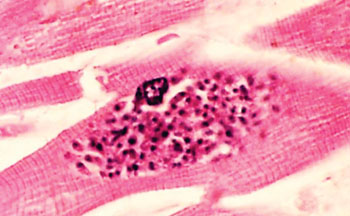Latent Toxoplasmosis Prevalence Analyzed Retrospectively
By LabMedica International staff writers
Posted on 01 Sep 2016
Primary maternal infection with Toxoplasma gondii during pregnancy can lead to prenatal infection of the unborn child, and vertical diaplacental transmission of Toxoplasma can seriously damage the embryo. Some prenatally infected children, asymptomatic at birth, can develop retinochorioiditis and other sequelae months or years later.Posted on 01 Sep 2016
In Austria, mandatory screening for the prevention of congenital toxoplasmosis stipulates a serological test for antibodies against T. gondii as early as possible in pregnancy. In the case of a seronegative result, subsequent tests at intervals of eight weeks are requested. If antibodies against the parasites are detected, the sample is further tested for specific immunoglobulin M (IgM) antibodies. A negative IgM report indicates a late latent infection that poses no threat for the current pregnancy.

Image: A histopathology of active toxoplasmosis of the myocardium. Numerous tachyzoites of Toxoplasma gondii are visible within a pseudocyst in a myocyte (Photo courtesy of Dr. Edwin P. Ewing, Jr.).
A team of scientists collaborating with the Labor Dr. Berghold (Graz, Austria) analyzed serological data from Styria, an Austrian federal state, to determine the sero-prevalence and incidence of Toxoplasma infections. The study included 353,599 tests from 103,316 women during 158,571 pregnancies from 1995 to 2012.
Three different test systems were used to screen for antibodies against T. gondii: from January 1, 1995, to June 18, 2006, the team used slides coated with T. gondii for indirect immunofluorescence test (IIFT). From June 19, 2006, to December 5, 2010, the determinations were made with the automated Vidas Toxo IgG System (bioMérieux, Marcy-l'Étoile, France). Since December 6, 2010, Toxoplasma IgG has been determined automatically using the Architect System (Abbott Diagnostics, Lake Forest, IL, USA). Toxoplasma IgM test to confirm seroconversion was determined with the following systems: the automated bioMérieux Vidas Toxo IgM System; the bioMérieux automated Vidia IgM assay; and since December 6, 2010, the automated Architect System IgM assay from Abbott Diagnostics.
The scientists found that the age-adjusted sero-prevalence decreased from 43.3% in 1995 to 31.5% in 2012, with a yearly decline of 0.84%. The intergravid incidence showed an annual decrease of 4.2%. The average yearly incidence of intragravid and intergravid seroconversions was 0.52% and 0.72%, respectively. Therefore it is to be expected that the sero-prevalence of latent Toxoplasma infections will continue to show a clear decrease. That means, however, that the number of women of childbearing age who are at risk of infection will increase. The net effect is that although primary infections in pregnancy are decreasing, prenatal toxoplasmosis will continue to pose a substantial threat to pregnant women and their children.
The main source of human Toxoplasma infections is seen to be consumption of undercooked meat and meat products. Modern technology in meat processing may have reduced the degree of contamination, and hygiene measures such as strict rodent control and cats in livestock barns help to reduce infection pressure. Deep-freezing meat for a number of days also helps to kill T. gondii. For some years, however, there has been a trend towards organic and free-range farming, and in such operations, there is a higher sero-prevalence of infection. The study was published on August 18, 2016, in the journal Eurosurveillance.
Related Links:
Labor Dr. Berghold
bioMérieux
Abbott Diagnostics














